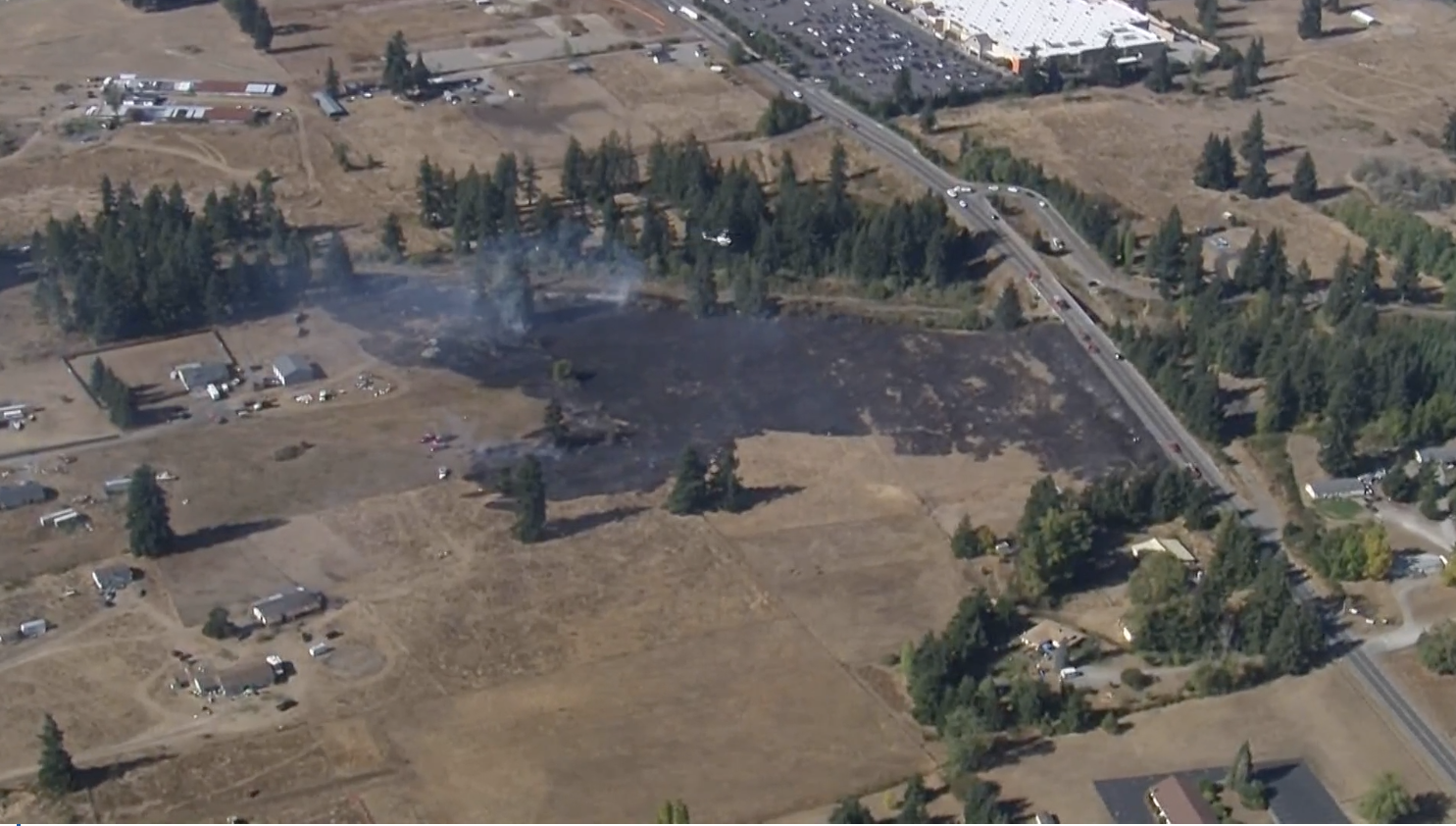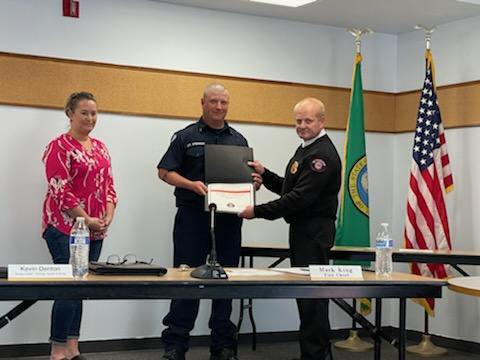A brush fire broke out Wednesday off SR 507 in Yelm. A few houses were evacuated, and road was closed but fire is now contained as of 2:04 pm


A brush fire broke out Wednesday off SR 507 in Yelm. A few houses were evacuated, and road was closed but fire is now contained as of 2:04 pm

Home fires are the most common type of emergency in the United States, and can cause deaths, injuries and property loss within minutes of breaking out. Home fires occur every day across the country but we can take action to prepare. Prepare now to protect yourself, your loved ones and your home. Click link to view list: EN_Home-Fire-Safety-Checklist
Home Heating Tips
No matter what you use to heat your home, ensuring your heating devices and systems are in good working order is essential to learning some fall-fire safety tips. Many things can go wrong with heating equipment during spring and summer; verify that everything you need to keep your home warm throughout fall and winter is in good working order before you experience the season’s first cold snap.
Central Heating System Safety Tips
Fireplace Safety Tips
Space Heater Safety Tips
Time Changes Mean Battery Changes
Outdoor Fall Fire Safety Tips
Safety Matters
There is nothing more important than the safety of your family. Everyone in your home needs to know how to behave responsibly to reduce the likelihood of experiencing a fire. Fires can start anytime without warning, and members of your household must know how to react in the event of a fire. It’s a good idea to review fire prevention and safety tips with your family every fall and several other times throughout the year.
Seattle has been issued an Excessive Heat Warning from the National Weather Service. Temperatures are predicted to be above 90 degrees Fahrenheit. Starting on July 26th, temperatures will begin in the low to mid-90s and increase throughout the week. Here are some tips to avoid illness caused by extreme weather.
Protecting Your Skin From the Sun
Clothes
When possible, wear long-sleeved shirts, pants, and skirts. This can provide UV protection; darker clothes made from tightly woven fabric can offer more protection. Wet material can provide less protection along with light-colored fabrics. Some clothes also offer UV protection and are certified under international standards.
Shade
Staying in the shade can prevent sun damage and skin cancer. Shade can be provided by an umbrella, tree, or cover. However, protective clothing and sunscreen are the best protection even when in the shade.
Hats
A hat with a brim covering your face, ears, and the back of your neck will provide the most protection for you—tightly woven fabrics such as canvas work the best to protect against UV rays. Avoid woven hats with holes that allow for sunlight to shine through. If you wear a baseball cap wearing clothing and sunscreen will help protect the areas that the hat does not cover.
Sunscreen
SPF or sun protection factor is a number assigned to sunscreens rating how effective they are in blocking UV rays. The general recommendation for sunscreen is to use a broad spectrum with an SPF of 15 or higher. A broad spectrum sunscreen will block both UVA and UVB rays. For maximum protection, a thick layer of sunscreen needs to be applied to all exposed skin, including hard-to-reach areas. Make sure to check if the sunscreen has expired. Most sunscreens have a shelf life of three years, which can be shorter if the product is exposed to high temperatures.
Sunscreen is not recommended for babies who are six months or younger. Instead, they should not be in the sun during midday and wear protective clothing when they are in the sun.
Reapplication of sunscreen should happen every two hours when you are outside and after swimming, sweating, and toweling off.
Learn more about sun exposure at Skin Cancer, CDC.
Heat Safety
Here is a list of things you can do to prevent heat-related illness.
In the event of a fire, your ability to escape depends on an advance warning from your fire alarms and planning in advance.
Even when the outside temperatures are high, water temperatures in the Thurston County area can be cold enough to overwhelm even the strongest swimmer. Sadly, SETFA responds to preventable drownings every year.
If you plan to be in or near water this summer, follow these recommendations:
Learn to swim, including water safety and survival skills — To enjoy the water safely, learn swim strokes, water safety, survival skills, and becoming comfortable in the water.
Wear a life jacket — Always wear a U.S. Coast Guard approved life jacket when boating, tubing, rafting, swimming or other activities in or on lakes, rivers, salt water, or pools without a lifeguard.
Swim where there is a lifeguard — Swim in areas with lifeguards when possible. Wear a life jacket while swimming in unguarded waters or until the guards start their service.
Supervise children in or near water — Always provide close and constant attention to children you are supervising in or near water. Stay within touching distance of young children at all times.
Do not use alcohol or drugs during water activities — Never use alcohol or other impairing drugs during water and boating activities or while supervising children around the water. Alcohol affects balance, coordination, and judgement. Exposure to sun and heat worsen these effects.
Learn first aid and CPR — Learn first aid and CPR. Seconds count—the more quickly lifesaving CPR is started, the better the chances of recovery. Dial 911 in an emergency.
 At this weeks board of commissioners meeting we formally celebrated a landmark accomplishment of a promotion. Congratulations to S.E. Thurston Fire Authority Dan Stewart on his promotion to Lieutenant! Lieutenant Stewart’s wife had the honor of pinning his badge. Thank you for your years of service and service to the community!
At this weeks board of commissioners meeting we formally celebrated a landmark accomplishment of a promotion. Congratulations to S.E. Thurston Fire Authority Dan Stewart on his promotion to Lieutenant! Lieutenant Stewart’s wife had the honor of pinning his badge. Thank you for your years of service and service to the community!
The weather is nicer and the sun is out more with summer here. We know you’re going to be doing more outside, including grilling, so we thought it was a good time to remind everyone to be safe while you enjoy the outdoors!
The Washington State Patrol has posted a list of safety tips on their website (here).
Originally posted on the Fire Protection Blog
Fire extinguishers don’t last forever. All fire extinguishers will expire at some point but there is not always a strict expiration date. As the first line of defense for a fire, it is important that you make sure your extinguishers are still functional and well maintained.
The lifespan of a fire extinguisher varies based on a few factors including:
According to NFPA standards, disposable fire extinguishers need to be replaced every 12 years and rechargeable fire extinguishers must be recharged every 6 years. A disposable fire extinguisher has a plastic head with a gauge that reads “full” or “empty”. Rechargeable extinguishers have a metal head with a gauge that reads “charge” or “recharge”.
Some extinguishers have a recommended replacement date set by the manufacturer. However, there are many extinguishers without strict expiration dates which can make it hard to tell when it should be replaced. Every month, you should do a visual check of your fire extinguishers to make sure that they are still functional. Some things you should look out for include:
Certain types of fire extinguishers are now considered obsolete as regulations change or technology advances. NFPA guidelines dictate which types of extinguishers should be removed from service. If you have an older fire extinguisher, you should consult with an experienced fire protection provider to determine whether it is obsolete.
Getting your fire extinguishers inspected, tested, and serviced according to NFPA and manufacturer recommendations can help to extend the lifespan of your equipment.
Fire safety is an important subject to discuss, especially with young ones. However, the discussion you have with a child in kindergarten versus a child in 6th grade are two different approaches. A good resource for information for both of those age groups (and those in between, of course) is Firesafekid.org. They have separate sections with information for grades K-3 and for grades 4-6.